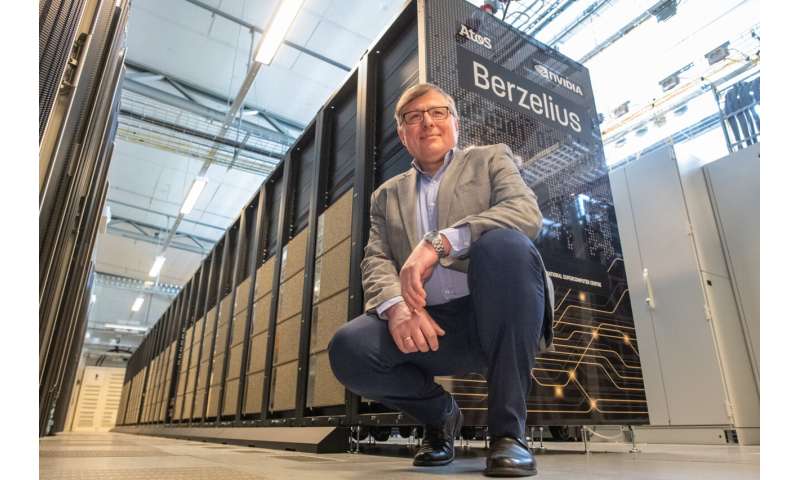Materials science at the service of humankind

Artificial nerve cells, electronic plants, cheap solar cells and new types of diodes are all examples of materials science conducted at Linköping University in Sweden. Igor Abrikosov, professor of theoretical physics, is convinced that research and development of new materials is a major key to a sustainable future.
"If you look at the seventeen UN sustainability goals you don't see materials mentioned explicitly. But if you take a deeper look, materials can be the solution to virtually any one of those goals," says Igor Abrikosov.
He is director of the strategic research area Advanced Functional Materials (AFM; the result of the Swedish Government's research bill that focused on material science) which has Linköping University as its host. The ambition of AFM is to accelerate material development both for commercial applications and as a base for future research.
But let us begin at the beginning.
The first material we as humans seem to have taken an interest in is stone. At least that is what is left from the first human beings in archaeological digs. Through the use of materials, we as humans have discovered news ways of altering our surrounding to fit us better.
"Materials science is important in the whole history of mankind. If you remember your elementary school lessons, we have the stone age, the bronze age and so on. This indicates the importance of materials," says Igor Abrikosov.
Stone axe to mobile phone
Almost all leaps in human history, from the first stone axe to the industrial revolution to your connected mobile phone, have to do with materials. There is a line, with materials as the common denominator, from the first humans hunting mammoths to you reading this article on digitally printed paper.
However, developing a new material is a slow process. So even though progress has been exponential since the stone age, it takes, at best, twenty years to develop a new functional material today.
Traditionally, materials science is based on a trial-and-error approach, also called an Edisonian approach, where you test a vast number of combinations of elements in the lab before reaching the desired result.
But the researchers at AFM take a different approach. Their goal is to change the process from fundamental research to application.
"If we can move from this trial-and-error approach to, what we call, a knowledge-based design, we can shorten the development period significantly. From twenty years to maybe four or five. Then it will even be possible to make materials on demand. This will be a game changer," says Igor Abrikosov.
Cumulated knowledge
Today, when an engineer needs a new material, they go to a catalog of existing materials and choose. The material chosen may still not be optimal for the application, but is as close as it can get right now. In the future, however, Igor Abrikosov envisions a scenario where engineers can order on demand a material with certain properties that best match the application requirements.
He believes that the great enabler of this accelerated development is a critical mass of knowledge. And within AFM there is no shortage of knowledge. Around a hundred and fifty researchers from several fields are connected to the research area, which provides a base for developing new ideas. Combined with new tools such as artificial intelligence, machine learning and theoretical simulations, this will enable the researchers to scan a lot more possible materials before they go into the lab and actually make the material.
"The material universe is pretty much unexplored so far. There are a lot of things that can, and need to, be found," says Igor Abrikosov.
Preserve all types of research
The research conducted in AFM spans from applied research that could be seen on the market as soon as in a few years' time, to the very most fundamental research that explores the limits of physics and chemistry, but has no apparent use at the moment.
An example of that is a study recently published in Nature Chemistry to which AFM researchers made significant contributions. According to Igor Abrikosov, the discovery of an aromatic nitrogen anion in very complex potassium-nitrogen compounds synthesized at high pressure, is a breakthrough discovery. Although it has no immediate apparent applications, something previously thought impossible is shown to be possible.
This opens for new knowledge and new perspectives and could be very important for future applications in medicine or chemical engineering.
"It's very important to understand that we must preserve all layers of research, fundamental, strategic and applied. Think about the discoveries made in the middle of the last century like the use of silicon. Without it, it would be impossible to have the technology we have today," he says.
Needed everywhere
Furthermore, material science is a platform for other research areas. For instance, space missions would not be possible without advanced materials. And the medical field is greatly in need of new materials—if you want better implants you need to find materials that mimic bones, if you want better MRI images you need better contrast agents and so on. In the industry, you need to find coating materials that are harder and stay sharp for cutting tools. And in quantum computers, you will need materials that can host quantum bits.
Materials can even be used as models for studying cosmology and the fundamental properties of our universe in the palm of your hand.
All this combined may help us understand our world as it is today, and the actions needed to make the best of it. Igor Abrikosov is convinced:
"Materials science is key to a sustainable future. Without it, we would be nowhere near where we are today."
More information:
Dominique Laniel et al, Aromatic hexazine [N6]4− anion featured in the complex structure of the high-pressure potassium nitrogen compound K9N56, Nature Chemistry (2023). DOI: 10.1038/s41557-023-01148-7
Provided by Linköping University